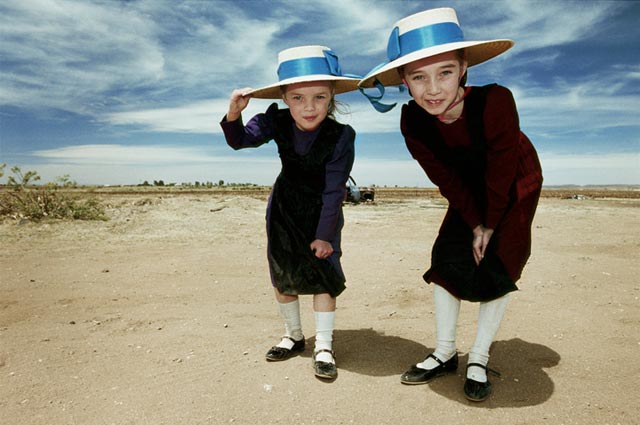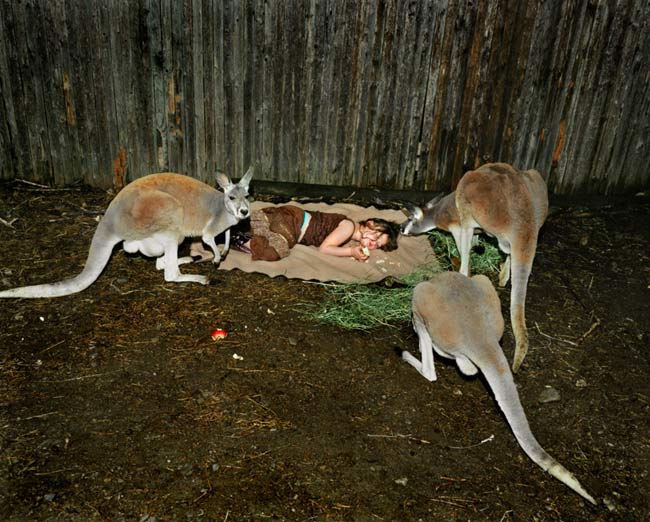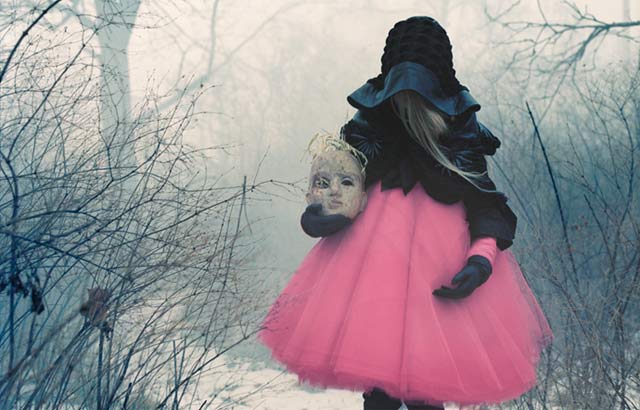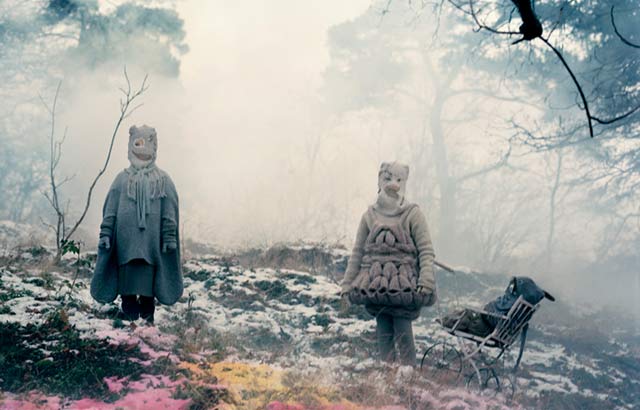kids

Who is harder to raise, sons or daughters? I’ve asked by a show of hands and with iClickers, over the years, and the room of 750 is almost unanimous: daughters are harder to raise. (…)
So then I show them this.
It is a graph of maternal longevity based on the number of sons or daughters they have. This data was based on a historical population from Finland from 1640-1870 using church records (Helle et al 2002). As you can see, the more sons mothers bear, the shorter their lifespans.
{ Context and Variation | Continue reading }
genders, kids, science | May 18th, 2011 12:26 pm

Yes, there’s a correlation between early sexual initiation (this study defined this as 16 or younger) and later sexual risk-taking. But, as a causal factor for sexual risk-taking—multiple partners, drug and alcohol use during sexual encounters, or unprotected intercourse—“it doesn’t really matter whether you delay sex or not.” (…)
The researchers looked at more than 1,000 pairs of identical and fraternal twins. (…) Numerous runs of the data led to the same conclusion: “You take two twins who share 100 percent of their genes. One has sex at 15 and one at 20. You compare them on risk-taking at 24—and they don’t differ.”
So why does someone end up sexually promiscuous? The researchers think it’s a combination of genetic factors—such as the strong inherited tendency to be impulsive or anti-social – and environmental ones, such as poverty or troubled family life.
{ APS | Continue reading }
photo { Robert Mapplethorpe, Calla Lily, 1987 }
kids, psychology, sex-oriented | May 18th, 2011 12:11 pm

Dr Bryan Caplan, an academic and economist from George Mason University in Virginia, believes parents are working far too hard at bringing up their children. (…)
“Quit fretting over how much TV your kids watch. Don’t force them to do a million activities they hate. Accept that your children’s lives are shaped mostly by their genes and their own choices, not by the sacrifices you make in hopes of turning them into successful adults.”
Caplan points to scientific evidence to support the idea of “serenity parenting.” Research on twins and on adopted children shows, he says, that parents’ long-term effects range from small to zero for a wide range of outcomes such as health and success. (…)
Research also shows that a child’s intelligence can be increased by parental interaction when they are very young, but by the time the child reaches 12 the effect has disappeared.
{ Guardian | Continue reading | More: Bryan Caplan on Parenting | EconTalk | Audio + Transcript }
controversy, kids | May 16th, 2011 4:25 pm

Compared with other mothers, women who deliver twins live longer, have more children than expected, bear babies at shorter intervals over a longer time, and are older at their last birth, according to a University of Utah study.
The findings do not mean having twins is healthy for women, but instead that healthier women have an increased chance of delivering twins, says demographer Ken. R. Smith, senior author of the study and a professor of family and consumer studies.
{ EurekAlert | Continue reading }
photo { Manolo Campion }
health, kids, science | May 10th, 2011 7:09 pm

Could Einstein’s Theory of Relativity be a few mathematical equations away from being disproved? 12-year-old Jacob Barnett thinks so. And, he’s got the solutions to prove it.
Barnett, who has an IQ of 170, explained his expanded theory of relativity — in a YouTube video. (…)
While most of his mathematical genius goes over our heads, some professors at the Institute for Advanced Study in Princeton, New Jersey — the U.S. academic homeroom for the likes of Albert Einstein, J. Robert Oppenheimer, and Kurt Gödel — have confirmed he’s on the right track to coming up with something completely new. (…)
“I’m impressed by his interest in physics and the amount that he has learned so far,” Institute for Advanced Study Professor Scott Tremaine wrote in an email to the family. “The theory that he’s working on involves several of the toughest problems in astrophysics and theoretical physics.”
“Anyone who solves these will be in line for a Nobel Prize,” he added.
{ Time | Continue reading + video }
kids, mathematics, science | May 10th, 2011 6:47 pm

Social convention of 1884, when FDR was photographed at age 2 1/2, dictated that boys wore dresses until age 6 or 7, also the time of their first haircut. Franklin’s outfit was considered gender-neutral.
But nowadays people just have to know the sex of a baby or young child at first glance, says Jo B. Paoletti, a historian at the University of Maryland and author of Pink and Blue: Telling the Girls From the Boys in America. (…)
For centuries, children wore dainty white dresses up to age 6. (…) The march toward gender-specific clothes was neither linear nor rapid. Pink and blue arrived, along with other pastels, as colors for babies in the mid-19th century, yet the two colors were not promoted as gender signifiers until just before World War I—and even then, it took time for popular culture to sort things out.
{ Smithsonian Magazine | Continue reading }
colors, flashback, genders, kids | April 13th, 2011 2:00 pm

In this article we provide a number of reasons for thinking that it is both wrong and unwise to procreate.
Humans are the most destructive creatures on the planet. We cause vast numbers of animal deaths (both directly and indirectly). We destroy habitats. We damage the environment. We are currently heating up the world’s climate in a way that is likely to be detrimental to countless numbers of animals (ourselves included). And we have the means, nuclear weapons, to destroy everything at the push of a button. (…)
The best way to stop the destruction is to remove the destructive force; to remove humans by refraining from procreation. In short, the colossal amount of harm caused by humans gives us a moral reason to boycott the human species. (…)
To procreate is to take an unjustifiable gamble that future generations will behave responsibly (more responsibly than us).
{ Gerald Harrison and Julia Tanner/Cambridge Journal | Continue reading }
related { Having children helped my depression }
future, ideas, kids | March 7th, 2011 6:28 pm
experience, kids, video | March 3rd, 2011 1:10 pm

The debate over the demographic trends in the United States and other wealthy countries can be described a debate between those who care about our children and those who want more of them. This is apparent once a little bit of logic is applied to the tales of demographic disaster being hawked by those concerned about declining birth rates and greater longevity.
The basic story is that we are seeing a declining ratio of workers to retirees. This is supposed to mean that our children and our grandchildren will have an unbearable burden supporting us in our old age. In the United States the story is that we now have about three workers for each retiree. In 20 years this ratio is supposed to drop to two.
In countries like Germany and Japan the decline is somewhat greater, since they have lower birth rates and, in the case of Japan, less immigration. They also have somewhat more rapid gains in longevity.
This basic story has managed to make otherwise sane people seriously fearful about the country and the world’s future. A quick statistic that should alleviate the fears is that the ratio of workers to retirees in the United States was 5 to 1 back in the 60s, far higher than the current 3 to 1 ratio.
{ Monthly Review | Continue reading }
photo { Gary Lee Boas }
future, ideas, kids | February 2nd, 2011 7:01 pm

Bryan Caplan complains about evo psych folk who say we didn’t inherit “an overwhelming, conscious desire to have children,” and about my suggestion that “It is hard to tell grand hero stories” about high fertility.
{ Overcoming Bias | Continue reading }
photo { Richard Foulser }
ideas, kids | December 16th, 2010 7:20 pm

Why does a child grow up to become a lawyer, a politician, a professional athlete, an environmentalist or a churchgoer?
It’s determined by our inherited genes, say some researchers. Still others say the driving force is our upbringing and the nurturing we get from our parents.
But a new child-development theory bridges those two models, says psychologist George W. Holden at Southern Methodist University in Dallas. Holden’s theory holds that the way a child turns out can be determined in large part by the day-to-day decisions made by the parents who guide that child’s growth.
Parental guidance is key. Child development researchers largely have ignored the importance of parental “guidance,” Holden says. In his model, effective parents observe, recognize and assess their child’s individual genetic characteristics, then cultivate their child’s strengths.
{ EurekAlert | Continue reading }
kids, science, theory | December 2nd, 2010 2:01 pm

{ The Parrot AR.Drone was definitely one of the highlights of our day. How can you top a quadricopter that can fight with another using augmented reality, is easy to fly, and only needs an iPhone to control it? | Engadget | more photos + video }
kids, technology, toys | November 30th, 2010 2:40 pm

In 1978, the divorce rate was much higher than it is today. (…)
Americans still venerate marriage enough to want to try it. About 70% of us have been married at least once, according to the 2010 Census. (…)
41% of babies were born to unmarried moms in 2008, an eightfold increase from 50 years ago, and 25% of kids lived in a single-parent home, almost triple the number from 1960. Contrary to the stereotype, it turns out that most of the infants born to unmarried mothers are not the product of casual sexual encounters. (…)
Most of those unwed mothers said their chances of marrying the baby’s father were 50% or greater, but after five years, only 16% of them had done so and only about 20% of the couples were still cohabiting. This didn’t mean that the children didn’t live with a man, however, since about a quarter of their moms were now living with or married to a new partner.
{ Time | Continue reading }
screenshot { Michelangelo Antonioni, The Eclipse, 1962 }
U.S., kids, relationships | November 29th, 2010 6:56 pm

Genie was a pseudonym for a girl who was found in extremely poor conditions. Not only were her surroundings incredibly unstimulating, they were also very dirty and horrid. The author of Philo-Psych (2009) states that “After it was revealed by a doctor that Genie’s language was slightly delayed, her father considered her retarded. Presumably to shelter her from a life of shame and embarrassment, he kept her in a room, strapped to a baby toilet, and only occasionally fed her baby food for 13 years.”
Although she was 13, she had the appearance of a 7 year old, and had extremely underdeveloped linguistic skills. Rather than talking, she made noises or yelps. The case of Genie presented psychologists with various questions over social, developmental and linguistic aspects of human development.
In the following video from the BBC’s Genie: A Deprived Child, we see what the story of Genie is all about, with those who worked with her.
{ John Wayland | Continue reading | video }
illustration { Ana Bagayan }
horror, kids, psychology | November 23rd, 2010 4:07 pm

What do you do when you’re stressed out?
Talk to friends? Listen to music? Have a drink, or eat some ice cream? Or maybe practice yoga? These things are all pleasant options, and they’re obvious, effective ways to deal with stress. Chances are that you would not even think about doing something like, say, cutting your arm with a knife until you draw blood. Yet inflicting pain is exactly what millions of Americans – particularly adolescents and young adults – do to themselves when they’re stressed.
This is called nonsuicidal self-injury (NSSI), and it most commonly takes the form of cutting or burning the skin. Traditionally, many doctors, therapists, and family members have believed that people engage in NSSI primarily to manipulate others.
However, recent research has found that such social factors only motivate a minority of cases. Although there are many reasons why people engage in this kind of self-injury, the most commonly reported reason is simple, if seemingly odd: to feel better. Several studies support the claim that self-inflicted pain can lead to feeling better.
{ Scientific American | Continue reading }
photo { Edward Weston }
kids, psychology | November 18th, 2010 2:45 pm
animals, kids, photogs | November 16th, 2010 6:00 pm
fashion, kids, photogs, weirdos | November 15th, 2010 6:40 pm

Words do hurt. Ridicule, distain, humiliation, taunting, all cause injury, and when it is delivered in childhood from a child’s peers, verbal abuse causes more than emotional trauma. It inflicts lasting physical effects on brain structure.
The remarkable thing about the human brain is that it develops after birth. Unlike most animals whose brains are cast at birth, the human brain is so underdeveloped at birth that we cannot even walk for months. Self awareness does not develop for years. Personality, cognitive abilities, and skills, take decades to develop, and these attributes develop differently in every person. This is because development and wiring of the human brain are guided by our experiences during childhood and adolescence. From a biological perspective, this increases the odds that an individual will compete and reproduce successfully in the environment the individual is born into, rather than the environment experienced by our cave-man ancestors and recorded in our genes through natural selection. Developing the human brain out of the womb cheats evolution, and this is the reason for the success of our species.
When that environment is hostile or socially unhealthy, development of the brain is affected, and often it is impaired. Early childhood sexual abuse, physical abuse, or even witnessing domestic violence, have been shown to cause abnormal physical changes in the brain of children, with lasting effects that predisposes the child to developing psychological disorders.
{ Psychology Today | Continue reading }
photo { Ken Rosenthal }
brain, kids, psychology | October 31st, 2010 8:34 am

The whole point of Halloween for kids these days is taking candy from strangers. Of course, that’s just what we are never supposed to do. (…)
And how many children have been harmed by randomly poisoned trick-or-treat candy? Approximately zero. (…) One California dentist in 1959 did pass out candy-coated laxatives, and some kids got bad stomachaches. But instances over the past 40 years where children were allegedly harmed by tainted candy have invariably fallen apart under scrutiny.
{ The Atlantic | Continue reading }
photo { Morad Bouchakour }
food, drinks, restaurants, kids | October 30th, 2010 5:12 pm

You can’t really thank your parents for being more than parents without crying and making everyone uncomfortable. You have to tell them that you ran out of Benadryl and you’re congested but that if you were to think of your most beautiful memory, it might be thirty seconds outside a Burger King in 1994. And for a second they don’t know what you mean, but then they know what you mean, like they always have.
{ Wipe your feet | Continue reading }
photo { Agnes Thor }
experience, kids, relationships | October 5th, 2010 2:00 pm
























